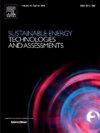沙特阿拉伯2030年愿景下气候对可再生能源系统优化配置和调度影响的比较研究
IF 7.1
2区 工程技术
Q1 ENERGY & FUELS
Sustainable Energy Technologies and Assessments
Pub Date : 2025-07-19
DOI:10.1016/j.seta.2025.104459
引用次数: 0
摘要
气候模式预估表明,太阳辐射和风的模式在未来几十年可能会发生变化。本研究的目的是根据当前(2020年)和2030年的气候预测,比较沙特阿拉伯(SA)三个城市太阳能、风能和化石能源设施的最佳配置和调度。本研究收集了所选城市的气候数据预测,并建立了一个电力生产的动态混合整数线性规划(MILP)模型。模型结果表明,太阳能发电系统是可再生能源发电的最佳选择。利雅得、达兰和吉达当前气候(2020年)的太阳能发电能力分别为43,300千瓦、31,420千瓦和4,006千瓦。整个系统的平准化成本为0.10美元/千瓦时,太阳能发电系统的运行时间为85%。如果太阳能发电能力被限制在40%,就像南非2030愿景中假设的那样,达兰将投资9,900千瓦的风力发电能力。风力发电的平准化成本为0.11美元/千瓦时,容量系数为10%。这些结果表明,SA的愿景应该考虑更高的太阳能渗透率。然而,如果其他限制限制了太阳能发电能力,那么风能和一些化石能源或核能发电可以补充太阳能发电系统。本文章由计算机程序翻译,如有差异,请以英文原文为准。
Comparative study of climate impacts on the optimal allocation and dispatch of renewable energy systems under Saudi Arabia’s 2030 vision
Climate model projections indicate that solar irradiation and wind patterns will likely change in future decades. The purpose of this study is to compare the optimal allocation and dispatch of solar, wind, and fossil-based energy facilities in three Saudi Arabia (SA) cities based on current climate (2020) and 2030 climate projections. This study gathers climate data projections for the selected cities and develops a dynamic mixed integer linear programming (MILP) model of electricity production. Model results suggest that solar power systems are optimal for renewable energy generation. Solar generation capacities for current climate (2020) in Riyadh, Dhahran, and Jeddah were 43,300, 31,420, and 4,006 kW, respectively. The systemwide levelized cost was $0.10/kWh, and solar power systems operate 85 % of the time. If solar capacity is limited to 40 %, as assumed in the SA 2030 SA vision, Dhahran would invest in 9,900 kW of wind generation capacity. The levelized cost of wind generation would be $0.11/kWh with a capacity factor of 10 %. These results suggest that the SA vision should consider higher solar energy penetration. However, if other constraints limit solar generation capacity, then wind and some fossil-based or nuclear energy generation could supplement solar power systems.
求助全文
通过发布文献求助,成功后即可免费获取论文全文。
去求助
来源期刊

Sustainable Energy Technologies and Assessments
Energy-Renewable Energy, Sustainability and the Environment
CiteScore
12.70
自引率
12.50%
发文量
1091
期刊介绍:
Encouraging a transition to a sustainable energy future is imperative for our world. Technologies that enable this shift in various sectors like transportation, heating, and power systems are of utmost importance. Sustainable Energy Technologies and Assessments welcomes papers focusing on a range of aspects and levels of technological advancements in energy generation and utilization. The aim is to reduce the negative environmental impact associated with energy production and consumption, spanning from laboratory experiments to real-world applications in the commercial sector.
 求助内容:
求助内容: 应助结果提醒方式:
应助结果提醒方式:


